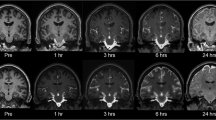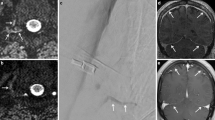Abstract
Purpose
Intrathecal gadolinium-enhanced MR cisternography (IGE-MRC) has a high sensitivity to detect accurate localization of cerebrospinal fluid (CSF) leakage in otorhinorrhea patients. Our purpose in this study was to describe our experience in analyzing clinically suspected CSF leakage by IGE-MRC by using gadobutrol with emphasis on its safety and diagnostic performance.
Methods
We retrospectively reviewed our imaging and clinical database for the evaluation of patients admitted to our clinic with complaints of otorhinorrhea between 2017 and 2019. Two radiologists evaluated the imaging studies independently. Consensus data was used in the analysis. Medical record review and phone call were used for the follow-up.
Results
Of the 85 patients included in the retrospective analysis, 82 (96.5%) had rhinorrhea and 3 (3.5%) had otorrhea. Overall, 29 patients (34.1% of all patients) underwent operation for repair of the CSF leakage site. Beta-transferrin test was available and positive in 33 patients (38.8%). Five (5.9%) patients complained headaches after the procedure and complaints were resolved with increased water intake. Postprocedurally, 3 patients (3.5%) had vertigo and 1 patient (1.2%) complained nausea but spontaneous regression were observed in a few hours. None of the patients experienced a significant complication or adverse reaction during follow-up period. Sixty-seven patients (78.8%) had medical record and telephone follow-up. Mean follow-up duration with call was 14.2 months.
Conclusion
IGE-MRC is a minimally invasive and highly sensitive imaging technique. The current results during our follow-up demonstrate the relative safety and feasibility of IGE-MRC by using gadobutrol to evaluate CSF leakage.


Similar content being viewed by others
References
Nacar Dogan S, Kizilkilic O, Kocak B, Isler C, Islak C, Kocer N (2018) Intrathecal gadolinium-enhanced MR cisternography in patients with otorhinorrhea: 10-year experience of a tertiary referral center. Neuroradiology 60:471–477. https://doi.org/10.1007/s00234-018-2014-4
Yi HJ, Zhao L-D, Guo W, Wu N, Li JN, Ren LL, Liu PN, Yang SM (2013) The diagnosis and surgical treatment of occult otogenic CSF leakage. Acta Otolaryngol 133:130–135. https://doi.org/10.3109/00016489.2012.727468
Manelfe C, Cellerier P, Sobel D, Prevost C, Bonafe A (1982) Cerebrospinal fluid rhinorrhea: evaluation with metrizamide cisternography. Am J Roentgenol 138:471–476. https://doi.org/10.2214/ajr.138.3.471
Sanus GZ, Ozlen F, Biceroglu H, Isler C, Tanriverdi T, Bas A, Albayram MS, Kaynar MY (2008) An experimental model of traumatic nasoethmoidal cerebrospinal fluid fistula. J Craniofac Surg 19:441–445. https://doi.org/10.1097/SCS.0b013e3181506477
Isler C, Ahmedov ML, Akgun MY et al (2018) Endoscopic endonasal cerebrospinal fluid leak repair on the ventral midline skull base: a single neurosurgical center experience. Turk Neurosurg 28:193–203. https://doi.org/10.5137/1019-5149.JTN.20009-17.1
Algin O, Turkbey B (2013) Intrathecal gadolinium-enhanced MR cisternography: a comprehensive review. AJNR Am J Neuroradiol 34:14–22. https://doi.org/10.3174/ajnr.A2899
Selcuk H, Albayram S, Ozer H, Ulus S, Sanus GZ, Kaynar MY, Kocer N, Islak C (2010) Intrathecal gadolinium-enhanced MR cisternography in the evaluation of CSF leakage. Am J Neuroradiol 31:71–75. https://doi.org/10.3174/ajnr.A1788
Albayram S, Kilic F, Ozer H, Baghaki S, Kocer N, Islak C (2008) Gadolinium-enhanced MR cisternography to evaluate dural leaks in intracranial hypotension syndrome. AJNR Am J Neuroradiol 29:116–121. https://doi.org/10.3174/ajnr.A0746
Yoo H-M, Kim SJ, Choi CG, et al Detection of CSF leak in spinal CSF leak syndrome using MR myelography: correlation with radioisotope cisternography. doi: https://doi.org/10.3174/ajnr.A0920
Algin O, Hakyemez B, Gokalp G, Ozcan T, Korfali E, Parlak M (2010) The contribution of 3D-CISS and contrast-enhanced MR cisternography in detecting cerebrospinal fluid leak in patients with rhinorrhoea. Br J Radiol 83:225–232. https://doi.org/10.1259/bjr/56838652
Algin O, Hakyemez B, Parlak M (2010) Phase-contrast MRI and 3D-CISS versus contrast-enhanced MR cisternography on the evaluation of the aqueductal stenosis. Neuroradiology 52:99–108. https://doi.org/10.1007/s00234-009-0592-x
Algin O, Hakyemez B, Parlak M (2011) Phase-contrast MRI and 3D-CISS versus contrast-enhanced MR cisternography for the detection of spontaneous third ventriculostomy. J Neuroradiol 38:98–104. https://doi.org/10.1016/j.neurad.2010.03.006
Aydin K, Terzibasioglu E, Sencer S, Sencer A, Suoglu Y, Karasu A, Kiris T, Turantan MI (2008) Localization of cerebrospinal fluid leaks by gadolinium-enhanced magnetic resonance cisternography: a 5-year single-center experience. Neurosurgery 62:584–589; discussion 584-9. https://doi.org/10.1227/01.neu.0000317306.39203.24
Tali ET, Ercan N, Kaymaz M, Pasaoglu A, Jinkins JR (2004) Intrathecal gadolinium (gadopentetate dimeglumine)-enhanced MR cisternography used to determine potential communication between the cerebrospinal fluid pathways and intracranial arachnoid cysts. Neuroradiology 46:744–754. https://doi.org/10.1007/s00234-004-1240-0
Reiche W, Komenda Y, Schick B, Grunwald I, Steudel WI, Reith W (2002) MR cisternography after intrathecal Gd-DTPA application. Eur Radiol 12:2943–2949. https://doi.org/10.1007/s00330-002-1606-9
Ecin G, Oner AY, Tokgoz N, Ucar M, Aykol S, Tali T (2013) T2-weighted vs. intrathecal contrast-enhanced MR cisternography in the evaluation of CSF rhinorrhea. Acta Radiol 54:698–701. https://doi.org/10.1177/0284185113478008
Aydin K, Guven K, Sencer S, Jinkins JR, Minareci O (2004) MRI cisternography with gadolinium-containing contrast medium: its role, advantages and limitations in the investigation of rhinorrhoea. Neuroradiology 46:75–80. https://doi.org/10.1007/s00234-003-1004-2
Arbeláez A, Medina E, Rodríguez M, Londoño AC, Castillo M (2007) Intrathecal administration of gadopentetate dimeglumine for MR cisternography of nasoethmoidal CSF fistula. AJR Am J Roentgenol 188:W560–W564. https://doi.org/10.2214/AJR.05.1280
Tali ET, Ercan N, Krumina G et al (2002) Intrathecal gadolinium (Gadopentetate Dimeglumine) enhanced magnetic resonance myelography and cisternography: results of a multicenter study. Investig Radiol 37:152–159
Jinkins JR, Rudwan M, Krumina G, Tali ET (2002) Intrathecal gadolinium-enhanced MR cisternography in the evaluation of clinically suspected cerebrospinal fluid rhinorrhea in humans: early experience. Radiology 222:555–559. https://doi.org/10.1148/radiol.2222010249
Zeng Q, Xiong L, Jinkins JR, Fan Z, Liu Z (1999) Intrathecal gadolinium-enhanced MR myelography and cisternography: a pilot study in human patients. Am J Roentgenol 173:1109–1115. https://doi.org/10.2214/ajr.173.4.10511188
Siebner HR, Gräfin von Einsiedel H, Conrad B (1997) Magnetic resonance ventriculography with gadolinium DTPA: report of two cases. Neuroradiology 39:418–422; discussion 422. https://doi.org/10.1007/s002340050436
Wenzel R, Leppien A (2000) Gadolinium-myelocisternography for cerebrospinal fluid rhinorrhoea. Neuroradiology 42:874–880. https://doi.org/10.1007/s002340000485
Edeklev CS, Halvorsen M, Løvland G, Vatnehol SAS, Gjertsen Ø, Nedregaard B, Sletteberg R, Ringstad G, Eide PK (2019) Intrathecal use of gadobutrol for glymphatic MR imaging: Prospective Safety Study of 100 Patients. AJNR Am J Neuroradiol 40:1257–1264. https://doi.org/10.3174/ajnr.A6136
Di Chiro G, Knop RH, Girton ME et al (1985) MR cisternography and myelography with Gd-DTPA in monkeys. Radiology 157:373–377. https://doi.org/10.1148/radiology.157.2.4048444
Ray DE, Holton JL, Nolan CC, Cavanagh JB, Harpur ES (1998) Neurotoxic potential of gadodiamide after injection into the lateral cerebral ventricle of rats. AJNR Am J Neuroradiol 19:1455–1462
Ray DE, Cavanagh JB, Nolan CC, Williams SC (1996) Neurotoxic effects of gadopentetate dimeglumine: behavioral disturbance and morphology after intracerebroventricular injection in rats. AJNR Am J Neuroradiol 17:365–373
Arlt S, Cepek L, Rustenbeck HH, Prange H, Reimers CD (2007) Gadolinium encephalopathy due to accidental intrathecal administration of gadopentetate dimeglumine [4]. J Neurol 254:810–812
Li L, Gao FQ, Zhang B, Luo BN, Yang ZY, Zhao J (2008) Overdosage of intrathecal gadolinium and neurological response. Clin Radiol 63:1063–1068. https://doi.org/10.1016/j.crad.2008.02.004
Kapoor R, Liu J, Devasenapathy A, Gordin V (2010) Gadolinium encephalopathy after intrathecal gadolinium injection. Pain Physician 13
Park K-W, Im S-B, Kim B-T, Hwang SC, Park JS, Shin WH (2010) Neurotoxic manifestations of an overdose intrathecal injection of gadopentetate dimeglumine. J Korean Med Sci 25:505–508. https://doi.org/10.3346/jkms.2010.25.3.505
Nayak NB, Huang JC, Hathout GM, Shaba W, el-Saden SM (2013) Complex imaging features of accidental cerebral intraventricular gadolinium administration. J Neurosurg 118:1130–1134. https://doi.org/10.3171/2013.2.JNS121712
Reeves C, Galang E, Padalia R, Tran N, Padalia D (2017) Intrathecal injection of gadobutrol: a tale of caution. J Pain Palliat Care Pharmacother 31:139–143. https://doi.org/10.1080/15360288.2017.1313353
Provenzano DA, Pellis Z, Deriggi L (2019) Fatal gadolinium-induced encephalopathy following accidental intrathecal administration: a case report and a comprehensive evidence-based review. Reg Anesth Pain Med 44:721–729
Popescu A, Patel J, McCormick ZL et al (2018) Fact finders for patient safety: are gadolinium-based contrast media safe alternatives to iodinated contrast agents for the safe performance of spinal injection procedures? Pain Med 19:2089–2090
Eide PK, Ringstad G (2015) MRI with intrathecal MRI gadolinium contrast medium administration: a possible method to assess glymphatic function in human brain. Acta Radiol Open 4:2058460115609635. https://doi.org/10.1177/2058460115609635
McDonald RJ, McDonald JS, Kallmes DF et al (2015) Intracranial gadolinium deposition after contrast-enhanced MR imaging. Radiology 275:772–782. https://doi.org/10.1148/radiol.15150025
Kanda T, Fukusato T, Matsuda M, Toyoda K, Oba H, Kotoku J’, Haruyama T, Kitajima K, Furui S (2015) Gadolinium-based contrast agent accumulates in the brain even in subjects without severe renal dysfunction: evaluation of autopsy brain specimens with inductively coupled plasma mass spectroscopy. Radiology 276:228–232. https://doi.org/10.1148/radiol.2015142690
Murata N, Gonzalez-Cuyar LF, Murata K, Fligner C, Dills R, Hippe D, Maravilla KR (2016) Macrocyclic and other non-group 1 gadolinium contrast agents deposit low levels of gadolinium in brain and bone tissue: preliminary results from 9 patients with normal renal function. Investig Radiol 51:447–453. https://doi.org/10.1097/RLI.0000000000000252
Berger F, Kubik-Huch RA, Niemann T, Schmid HR, Poetzsch M, Froehlich JM, Beer JH, Thali MJ, Kraemer T (2018) Gadolinium distribution in cerebrospinal fluid after administration of a gadolinium-based MR contrast agent in humans. Radiology 288:703–709. https://doi.org/10.1148/radiol.2018171829
Nehra AK, McDonald RJ, Bluhm AM et al (2018) Accumulation of gadolinium in human cerebrospinal fluid after gadobutrol-enhanced MR imaging: a prospective observational cohort study. Radiology 288:416–423. https://doi.org/10.1148/radiol.2018171105
McDonald RJ, McDonald JS, Kallmes DF et al (2017) Gadolinium deposition in human brain tissues after contrast-enhanced MR imaging in adult patients without intracranial abnormalities. Radiology 285:546–554. https://doi.org/10.1148/radiol.2017161595
Funding
No funding was received for this study.
Author information
Authors and Affiliations
Contributions
Osman Kizilkilic conceived of the presented idea. Osman Kizilkilic and Sebahat Nacar Dogan developed the theory and evaluated all DWI on PACS system independently. Both Bora Korkmazer and Serdar Arslan the analytical methods. Vefa Salt reviewed the medical records. All authors discussed the results and contributed to the final manuscript.
Corresponding author
Ethics declarations
Conflict of interest
The authors declare that they have no conflict of interest.
Ethical approval
All procedures performed in the studies involving human participants were in accordance with the ethical standards of the institutional and/or national research committee and with the 1964 Helsinki Declaration and its later amendments or comparable ethical standards.
Informed consent
Informed consent was obtained from all individual participants included in the study.
Additional information
Publisher’s note
Springer Nature remains neutral with regard to jurisdictional claims in published maps and institutional affiliations.
Rights and permissions
About this article
Cite this article
Dogan, S., Salt, V., Korkmazer, B. et al. Intrathecal use of gadobutrol for gadolinium-enhanced MR cisternography in the evaluation of patients with otorhinorrhea. Neuroradiology 62, 1381–1387 (2020). https://doi.org/10.1007/s00234-020-02463-3
Received:
Accepted:
Published:
Issue Date:
DOI: https://doi.org/10.1007/s00234-020-02463-3




